Maine in the China Trade
by Tom Seymour
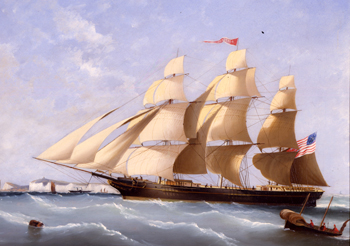
The clipper ship Portland. The clipper ship’s long narrow hull, wetted surface design, tall masts and large sail capacity made it “the” ship for the Trans Pacific China Trade. Photo collection of Maine Historical Society.
As far back as the colonial period, Americans had developed a taste for Chinese goods. But with British warships patrolling the seas, such a trade was impossible. Immediately after the Treaty of Paris in 1783, ending war between the United Colonies and Great Britain, restrictions upon American trade with China were immediately removed.
On February 22, 1784, The Empress of China left New York Harbor bound for China. The ship carried woolen cloth, lead, silver and ginseng. The Empress of China remained in China until December 28 of the same year, when she left Canton, bound for New York Harbor. Cargo on the return trip included tea, trousers made of Chinese fabric and porcelain.
These goods were quickly gobbled up by American consumers. The America-China trade had begun.
Limited Access
Foreigners were not
permitted to learn
the Chinese language.
The period beginning in 1784 and lasting until the 1840s was known as the time of the “Old China Trade.” During that time access to Chinese merchants was limited in that foreign traders were only allowed to trade with Cohong merchants (a guild of Chinese merchants or hongs who operated the import-export monopoly) and then only in the city of Canton. Foreign trading vessels en route to Canton were required to stop at Macao and there to contract with a Chinese river pilot for the voyage up Pearl River to the harbor at Canton.
According to an article posted by the Penobscot Marine Museum, Canton, China, was a walled city. Outside the walls, a ¼-mile strip of land on an island a few hundred feet from shore was devoted to foreign merchants. There, traders of various nationalities lived in trading houses, where they conducted business from March to November. During the winter months merchants sailed back to Macao, where they remained with their families until the next season’s trading began.
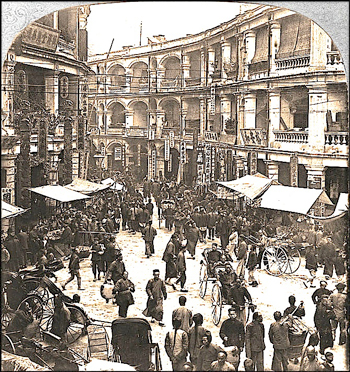
Queen’s Road on Chinese New Years day, Hong Kong, China 1902 Carlton H. Graves photo.
Foreign traders operated under tight restrictions. It was illegal for them to travel outside of Canton. Also, foreigners were not permitted to learn the Chinese language and because of this were restricted to employing interpreters, who spoke in pidgin. (The history of pidgin began in the early 19th century in the South China city of Canton. Chinese merchants interacting with English speakers on the docks in this port adopted and modified the word business in a way that, by century’s end, had become pidgin. The word itself then became the descriptor of the unique communication used by people who speak different languages. Pidgins generally consist of small vocabularies - Chinese Pidgin English has only 700 words.)
This restrictive Chinese policy stemmed from their belief that China was a more civilized country, both spiritually, economically and culturally. The foreigners were deemed barbarians and pagans. China had had a much longer history of organized, civil urban society. When London was the largest city in western Europe in 1600 with a population of 200,000, China had several cities with populations of 1 million.
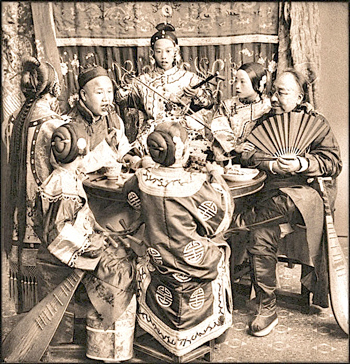
Mandarin girls in traditional dress playing musical instruments. Bejing, China 1861.
China’s “kowtow” ritual, where foreigners genuflected and prostrated themselves to Chinese merchants and authorities. This to some extent, mirrored the less extreme western European expectation of the same before members of the royal court and the church. British and American traders considered this demeaning and often refused to participate. This refusal to comply caused friction between China and some westerners.
While consumers in the western world desired Chinese goods, the Chinese had little need for goods imported from other countries. The Chinese were convinced that they had no need for foreign goods, since they already had many superior products. China had a long history of trade, which included travel along the Silk Road to the middle east in the 12th century. In 1425, 50 years before Columbus sailed the 84 foot Santa Maria to the “new world”, 400-foot, nine-masted Chinese trading ships were sailing the African coast.
The Chinese had little
need for goods imported
from other countries.
This disparity made it difficult to establish trade. But the fact was, Westerners had developed a taste for China tea, porcelain, fabric and a number of other items. The list of novel Chinese products available is too long to list here. Chinese inventions and products, some available centuries before the arrival of European and American traders include the compass, paper, tea, porcelain, gunpowder, moveable type, bar soap, silk, the abacus calculator, ice cream and toilet paper.
Accordingly, western traders needed to find items that the Chinese would accept. Ginseng and furs were two top trade items. Other less-important trade items included shark fins, bird’s nests and sea slugs.
So despite trade in the above-named western items, Chinese goods always wound up having a greater value than European goods and the Chinese insisted that the balance be made up in silver.
Competition Increases
As the years passed, competition between American and British interests for the China trade became increasingly spirited. It was soon clear that faster ships were instrumental in tipping the scales and that knowledge was paramount in the development of clipper ships. America began building these fast vessels, ships that easily outpaced their slower, British rivals. The need for fast ships was in part due to the propensity of tea to lose its flavor during long voyages in the hulls of sailing ships. The faster the tea could be transported back to America, the better the quality and the better it sold.
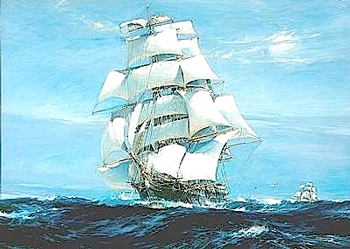
Tea clipper carrying it’s full set of sails, including the outer flying jib sails. Lower capacity was offset by greater speed.
Although clipper ships were a new development, the need for speed was not. In 1935, Howard Chapelle in, The History of American Sailing ships, wrote, “The great American deity, ‘speed,’ had no more devout worshippers than the designers and builders of privateers and of the small slaving craft that followed them.”
In an April, 2006 article in Fishermen’s Voice, Mike Crowe wrote, “With a limited formal naval force, the American government during and after the Revolution granted private ship owners the right to attack enemy merchant ships. These privateers could keep whatever was taken, cargo and ship, as a prize if they could outsail armed British frigates. Owner, officers and crew held shares as have some fishing vessels.”
In his article, he went on to address clipper ships, “The early clippers had steeply raked masts, square topsails over the gaff-rigged main, a huge gaff-rigged sail with a square topsail on the aft mast and a few flying jibs. This rig was popular but only one of many variations, for it was the underwater profile of the clipper ship that was uniformly similar. The Baltimore clipper was less a specific type than a name associated with clippers, as many were built on that part of the Atlantic coast. Many of the later, larger clippers were built by Donald McKay in East Boston, but Maine yards built their share. As more clippers were built, different rigging plans were used. The larger mid-century vessels were ship rigged (square rigged), and some captains experimented with these rigs.”
The age of the great clipper ships had begun and Maine figured prominently into the mix. The bulk of clipper ships were built in the great maritime centers of the east coast and around 60 were built in Maine. Not all clipper ships participated in the China trade, but many did and one vessel of note was Snow Squall, built in Portland, Maine.
Faster ships were
instrumental in
tipping the scales.
Clipper ships represented the pinnacle of the age of sail, floating superlatives, faster than any other vessels of the day. In fact, clipper ships handily cut the time of voyages between the United States and China by 50 percent. Their size alone served to impress and even intimidate. Some clipper ships stood at 20 stories high from deck to masthead.
American participation in the China trade lessened during the years prior to, during and just after the Civil War. Then, later in the 1860’s, trade resumed. But by then, China had dropped in ranking down to the United States’ fifth trading partner, with England and France being first and second. Cuba ranked third.
Cuban molasses, the basic ingredient of rum, was a highly desired import item. The Cubans, up to then, had relied upon black slaves as laborers on their sugar cane plantations but after emancipation, their source of free labor was severed and they had to seek an alternative. They found it in the form of Chinese laborers.
According to the Penobscot Marine Museum, about 150,000 Chinese had traveled to Cuba on sailing ships. Up to 15 percent of these people died en route. The museum owns a collection of papers from Rockland sea captain, Thomas Pillsbury. Pillsbury carried some 500 Chinese laborers to Havana in 1861. Cuba paid Pillsbury only for each man delivered alive, with no extra accommodation for those who had perished en route.
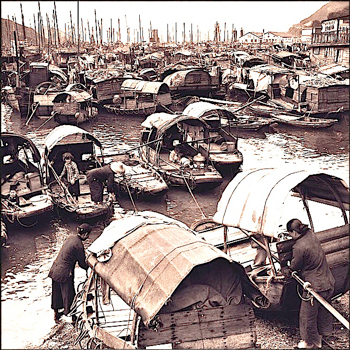
Fishing families with their sampan boats. Aberdeen Harbor, Hong Kong Harbor, 1946 Hedda Morrison photo.
Whether these Chinese workers were paid or rather, were forced into servitude, remains an unanswered question. In 1862, American president Abraham Lincoln signed a law banning American citizens from engaging in the questionable practice of transporting Chinese laborers to Cuba.
After this, Maine continued in the China trade and one prominent Searsport family, the Colcords, were very involved. Captain Lincoln A. Colcord and his wife, Jane French Sweester Colcord, sailed together, as did so many Maine seafaring families. Their children, Joanna and Lincoln Colcord were born at sea. The family frequently sailed together, with the children keeping up with their school lessons on board ship.
Records in the Penobscot Marine Museum indicate that Captain and Mrs. Colcord, along with daughter Joanna, made several voyages to the Orient on the State of Maine. During the second voyage, Joanna, who by then had become an accomplished photographer, took pictures of the voyages.
During the heyday of clipper ships, it was common for wives to accompany their husbands on long sea voyages. It was estimated that approximately half of the Searsport ship captains took their wives along on their extended trips. These hardy women raised and educated their children while at sea. Some even took over after running the ships when their husbands unexpectedly passed away.
One Maria Whall Waterhouse is said to have confronted mutineers after her sea-captain husband died at sea. This she did with the help of her deceased husband’s pistols and support from the ship’s cook. Such was the timbre of Maine sea captain’s wives.
The China trade, via sailing ships, continued through the end of the 19th century. And Maine played a large part in it.
